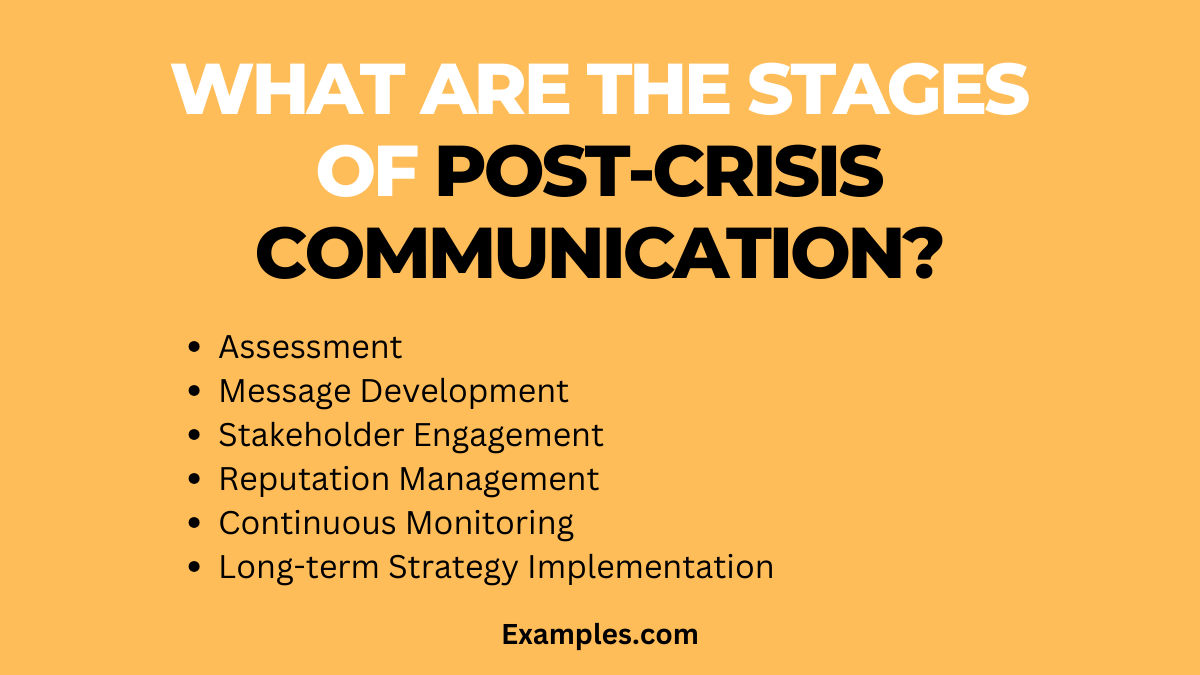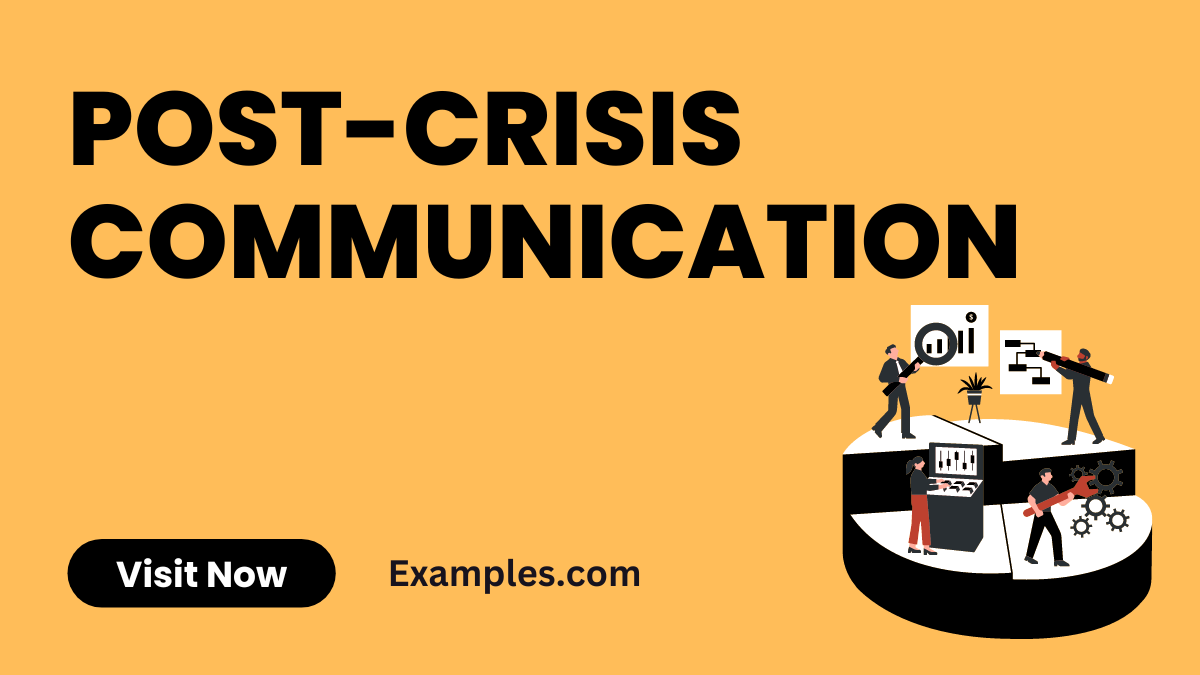19+ Post-Crisis Communication Examples
Post-crisis communication is a pivotal aspect of crisis management, focusing on rebuilding trust and restoring normalcy after an incident. It involves transparent, empathetic communication aimed at addressing concerns and providing updates. Essential in mitigating long-term damage, post-crisis communication requires skillful handling of media, stakeholders, and public perception. This guide delves into its history, origin, and practical applications, offering valuable tips and real-world examples to master effective communication strategies in the aftermath of a crisis.
What is Post-Crisis Communication?

Post-crisis communication is the process of engaging with stakeholders after a crisis has been resolved. It involves conveying information about the crisis resolution, steps taken to prevent future incidents, and efforts to rebuild trust and confidence. This communication is crucial for restoring normalcy, addressing any remaining concerns, and demonstrating accountability and commitment to improvement. Effective post-crisis communication can significantly influence an organization’s recovery and reputation management.
20 Post-Crisis Communication Examples
Post-crisis communication is a critical phase in crisis management, aimed at rebuilding trust, addressing concerns, and providing clear, transparent updates. It involves engaging stakeholders with honest and empathetic messaging to restore confidence and move forward. This section showcases 20 practical examples of post-crisis communication, each with a two-line explanation on how to effectively convey messages in everyday situations. These examples are designed to illustrate the nuanced approach needed in the aftermath of a crisis, focusing on reassurance, accountability, and the steps taken towards resolution. By understanding these examples, you can learn how to navigate post-crisis scenarios with tact and effectiveness.
- “We have thoroughly investigated the issue and implemented new safety measures to prevent future occurrences.” This sentence reassures stakeholders that proactive steps have been taken for safety and improvement.
- “We sincerely apologize for the inconvenience caused and are committed to making things right.” This demonstrates taking responsibility and a commitment to rectifying the situation.
- “Thank you for your patience during this time. We value your support as we work towards a resolution.” Expresses gratitude and acknowledges the importance of continued support.
- “We have provided additional training to our staff to ensure a higher standard of service.” Indicates a tangible step towards improvement and quality assurance.
- “We are offering a compensation package to those affected as a gesture of our commitment to customer satisfaction.” Shows a tangible effort to make amends.
- “We have updated our policies to reflect a more customer-centric approach.” Communicates organizational changes for better service.
- “Your feedback has been instrumental in our improvement process. We are listening.” Acknowledges the value of stakeholder input in making changes.
- “We will continue to provide regular updates as more information becomes available.” Promises ongoing transparency and communication.
- “Our team is available to answer any questions and address concerns you may have.” Offers direct lines of communication for further inquiries.
- “We are conducting a comprehensive review to better understand and learn from this event.” Shows a commitment to learning and growth.
- “We have partnered with industry experts to enhance our protocols and practices.” Indicates collaboration with experts for improvement.
- “Please visit our website for detailed information and resources related to this issue.” Directs stakeholders to a central information source.
- “We are deeply sorry for any distress caused and are here to support you.” Expresses empathy and readiness to assist.
- “We have established a task force to oversee the implementation of new measures.” Demonstrates proactive management and oversight.
- “Your safety and satisfaction remain our top priorities as we move forward.” Reaffirms commitment to key stakeholder concerns.
- “We are committed to regaining your trust through our actions and improvements.” Focuses on rebuilding trust through concrete actions.
- “We encourage open dialogue and welcome your suggestions on how we can improve.” Invites ongoing stakeholder engagement and feedback.
- “As part of our commitment to transparency, we are releasing a detailed report on the incident.” Provides accountability through information sharing.
- “We have enhanced our systems and processes to better serve you in the future.” Communicates improvements in operations.
- “We value your continued relationship and are dedicated to earning back your confidence.” Emphasizes the value of ongoing relationships and trust-building efforts.
What are the Important Rules of Post-Crisis Communication?
Here are the Important Rules of Post-Crisis Communication:
- Maintain Transparency: Continue being open and honest in your communications. Transparency post-crisis helps to rebuild trust and credibility.
- Reflect and Learn: Critically evaluate the crisis and its management to extract key lessons. This reflection is crucial for improving future crisis response strategies.
- Rebuild Trust: Actively work on restoring confidence among stakeholders. Trust rebuilding is a gradual process that requires consistent effort and genuine communication.
- Keep Communicating: Regularly engage with stakeholders to demonstrate ongoing commitment and progress. Continuous communication is vital to maintain a connection with your audience.
- Address Lingering Concerns: Identify and address any remaining issues or uncertainties. Addressing these concerns promptly helps in closing the chapter on the crisis.
- Thank Stakeholders: Express gratitude for the support and patience shown by stakeholders during the crisis. Acknowledging their contribution fosters goodwill and strengthens relationships.
What are the Stages of Post-Crisis Communication?

Here are the Stages of Post-Crisis Communication:
- Assessment: Conduct a thorough evaluation of how the crisis and the initial communication strategies impacted both the organization and its stakeholders.
- Message Development: Formulate clear and concise messages that address key post-crisis concerns, focusing on transparency and the steps taken to mitigate future risks.
- Stakeholder Engagement: Maintain an open line of communication with stakeholders, updating them on recovery efforts and listening to their feedback.
- Reputation Management: Implement strategies aimed at rebuilding trust and restoring the organization’s reputation. This might include highlighting positive actions taken during and after the crisis.
- Continuous Monitoring: Keep an eye on public sentiment, industry trends, and stakeholder feedback to gauge the effectiveness of the post-crisis communication.
- Long-term Strategy Implementation: Develop and execute long-term plans that incorporate lessons learned from the crisis, ensuring ongoing improvement and preparedness.
How to Conduct a Post-Crisis Communication?
Here are the steps for conducting post-crisis communication:
- Evaluate the Crisis Impact: Conduct a thorough assessment to understand the extent of the crisis’s impact on both the organization and its stakeholders. This evaluation is crucial for addressing specific concerns in your communication.
- Develop a Clear Message: Formulate a message that directly addresses the outcomes and implications of the crisis. This message should be concise, transparent, and focused on key points.
- Acknowledge and Apologize: If the situation warrants, openly acknowledge any mistakes made and offer genuine apologies. This step is vital for rebuilding trust.
- Highlight Lessons Learned: Communicate what the organization has learned from the crisis. Discuss how these lessons will influence future strategies and actions.
- Reaffirm Commitment: Emphasize the organization’s dedication to its core values and its commitment to stakeholders. This reaffirmation helps in restoring confidence.
- Plan for Ongoing Updates: Establish a schedule for providing updates as the organization moves forward from the crisis. Continuous communication is key to maintaining stakeholder engagement and demonstrating progress.
Tips for Developing Effective Post-Crisis Communication Strategy
Here are the tips for developing an effective post-crisis communication strategy:
- Stakeholder Analysis: Identify the stakeholders impacted by the crisis and understand their specific concerns. Tailor your communication to address these concerns, demonstrating that you understand and value their perspective.
- Message Development: Focus your messages on being transparent about what occurred, taking accountability for any mistakes, and detailing measures for future prevention. This approach helps in rebuilding trust and credibility.
- Channel Selection: Choose the most effective communication channels for your target audience. Consider a mix of traditional and digital media based on where your stakeholders are most likely to engage.
- Timely Execution: It’s crucial to implement your post-crisis communication strategy promptly to demonstrate responsiveness and control of the situation.
- Feedback Mechanism: Incorporate a way for stakeholders to give feedback on your crisis response. This could be through surveys, social media, or direct communication channels.
- Continuous Improvement: Use the feedback received to refine and improve your communication strategies. This step is essential for learning from the crisis and enhancing your crisis management protocols.
In conclusion, post-crisis communication plays a crucial role in rebuilding trust and restoring normalcy after a crisis. It involves transparently addressing the aftermath, providing updates, and taking responsibility where necessary. Effective post-crisis strategies can significantly influence public perception and an organization’s recovery path, emphasizing the importance of timely, honest, and empathetic communication in maintaining long-term stakeholder relationships and reputation management.



